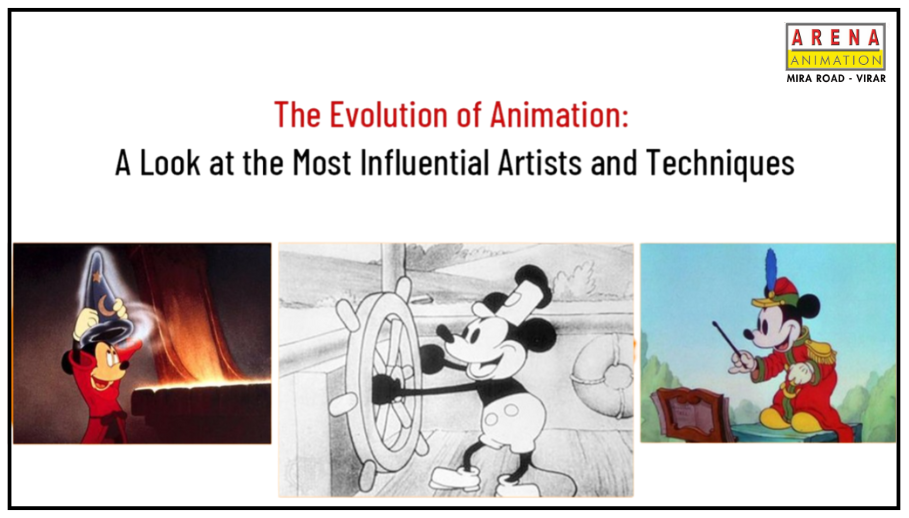From Hand-Drawn to Digital: The Evolution of Animation in Movies & Games

The Evolution of Animation: From Traditional to Digital
Animation has come a long way. From the early days of hand-drawn cartoons to today’s hyper-realistic CGI, the world of animation has transformed drastically. Whether you love animated movies, want to create your own stories, or are considering joining animation classes, this blog will take you through the exciting journey of animation’s evolution.
1. The Beginning of Animation: Traditional Methods
Before computers, animation was done by hand. Artists drew each frame on paper, and when these drawings were played in sequence, they created movement. This was known as traditional animation or hand-drawn animation. Some famous examples include:
- Steamboat Willie (1928) – The first animated film with synchronized sound, starring Mickey Mouse.
- Snow White and the Seven Dwarfs (1937) – The first full-length animated feature film by Disney.
What were the techniques used in traditional animation?
Some of the most common methods included:
- Flipbook Animation – Small drawings on the corner of a book that create movement when flipped.
- Cel Animation – Characters were drawn on transparent sheets (cels) and layered over painted backgrounds.
- Stop-Motion Animation – Real objects were moved frame by frame, like in Claymation.
Although traditional animation took a lot of time and effort, it laid the foundation for modern techniques.
2. The Shift to Digital Animation
With the advancement of technology, animators started using computers to create animations. Computer-generated imagery (CGI) changed everything! Instead of drawing each frame by hand, artists could now use software to create smooth, lifelike animations.
How did digital animation change the industry?
- It made animation faster and more efficient.
- It allowed for more realistic movements and expressions.
- It opened the doors for VFX (Visual Effects), seen in movies like Avengers and Avatar.
Some of the biggest milestones in digital animation include:
- Toy Story (1995) – The first full-length 3D animated movie by Pixar.
- Shrek (2001) – Showed how CGI could be used for storytelling in new ways.
- The Lion King (2019) – Used photorealistic CGI to recreate classic animations.
3. The Role of Animation in Today’s World
Today, animation is everywhere—not just in movies but also in gaming, advertising, and social media. With digital tools, anyone can learn animation by joining animation classes, VFX classes, and graphic designing classes. If you’re interested, you can explore an animation course in Virar or an animation course in Mira Road to get started.
4. Common Questions About Animation
Q: What software is used for animation today?
Some of the most popular software used in animation include:
- Autodesk Maya – Used for 3D animation and VFX.
- Blender – A free tool for 3D modeling and animation.
- Adobe After Effects – Great for 2D motion graphics and video editing.
If you want to learn how to use these tools, you can take a motion course in Mira Road or a video editing course in Virar.
Q: What are the career options in animation?
Animation offers multiple career paths, such as:
- 2D Animator – Creates hand-drawn or digital 2D animations.
- 3D Animator – Works with 3D models for movies and games.
- VFX Artist – Adds special effects to films and videos.
- Graphic Designer – Designs visual content for advertising and branding.
If you’re looking for the best institute for graphic design in Virar or Mira Road, check out local training centers to develop your skills.
Q: Is animation a good career choice?
Yes! The demand for animation and VFX classes is growing rapidly. Many industries, including entertainment, advertising, and gaming, require skilled animators. By joining an animation course in Virar or a VFX class in Mira Road, you can start your journey toward an exciting career.
5. The Future of Animation: What’s Next?
The future of animation is more exciting than ever. With advancements in artificial intelligence (AI), virtual reality (VR), and real-time rendering, animation is becoming more immersive. Some trends to watch include:
- AI-powered animation – AI is being used to automate certain animation processes.
- Virtual Reality (VR) and Augmented Reality (AR) – These technologies are creating interactive experiences.
- Real-time rendering – Used in video games and live animation performances.
As the industry grows, more opportunities will be available for those who invest in learning animation through motion classes and video editing courses in Mira Road or Virar.
Final Thoughts
Animation has come a long way, from simple hand-drawn sketches to advanced digital creations. Whether you’re passionate about movies, gaming, or visual effects, learning animation can open up many career opportunities. If you’re ready to start, explore animation classes, graphic designing classes, or even a VFX class in Virar to gain the skills needed in this exciting industry.
Want to learn more? Follow us on social media for updates and insights:
🔹 Instagram: Arena Animation Mira Road & Virar
🔹 Facebook: Arena Animation Mira Road & Virar
🔹 Twitter: @VirarArena
🔹 YouTube: Arena Animation Virar
🔹 LinkedIn: Arena Animation Mira Road & Virar
📖 Read more blogs here: Arena Animation Blog